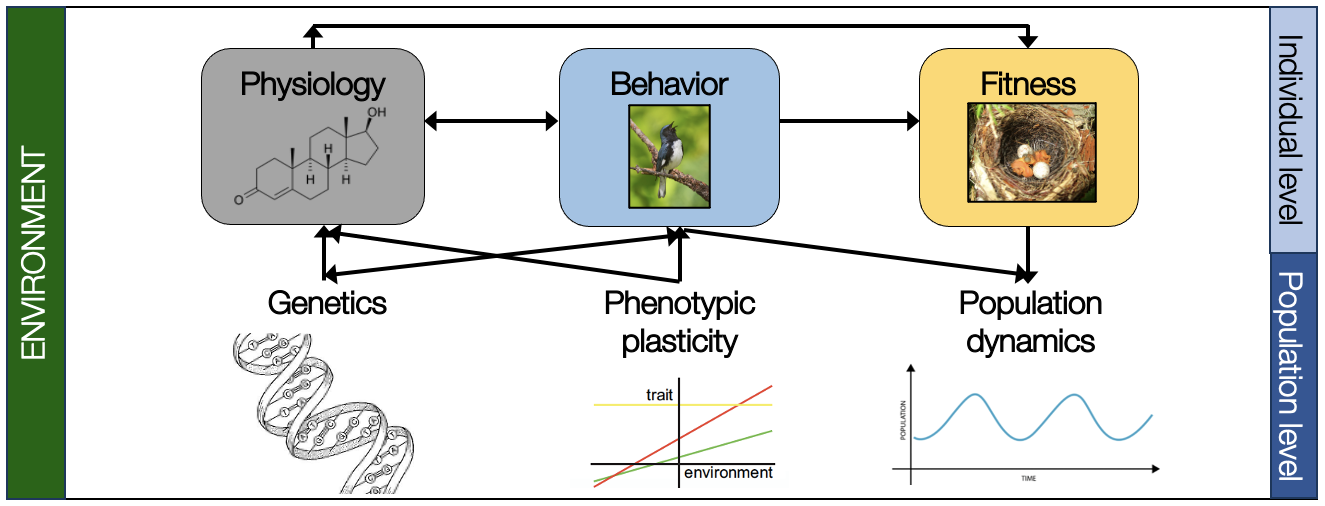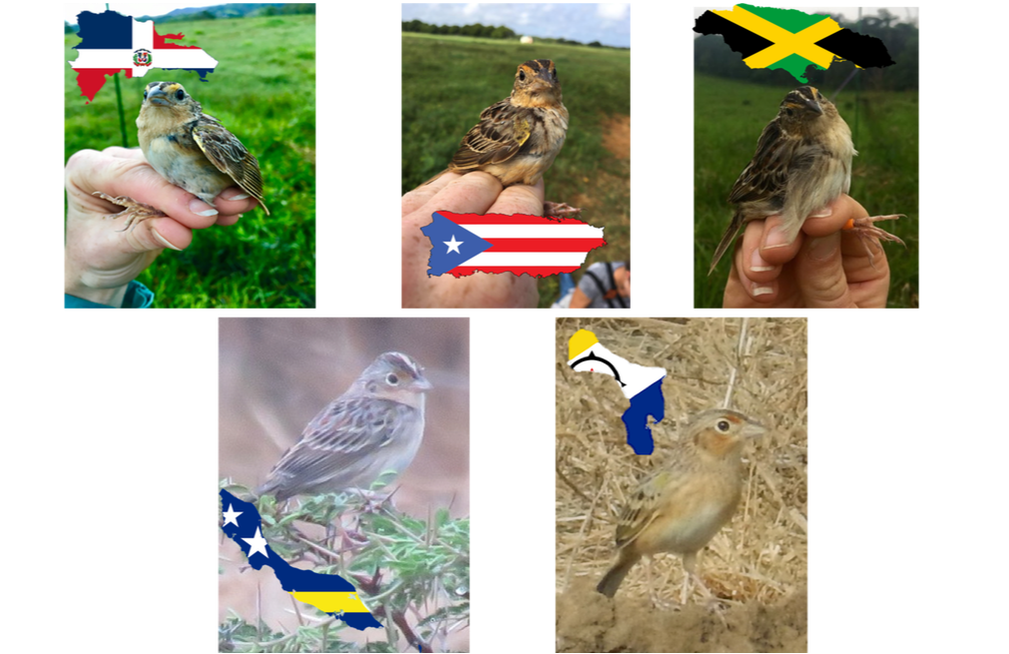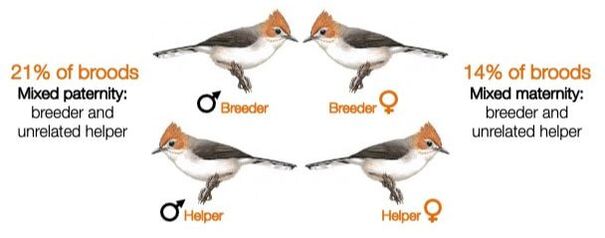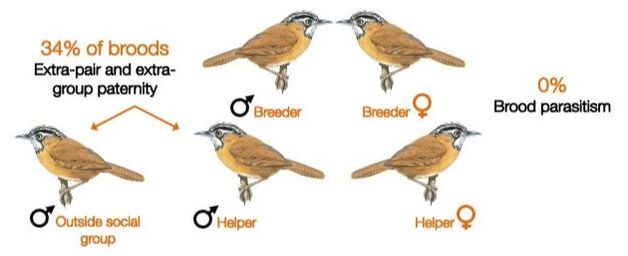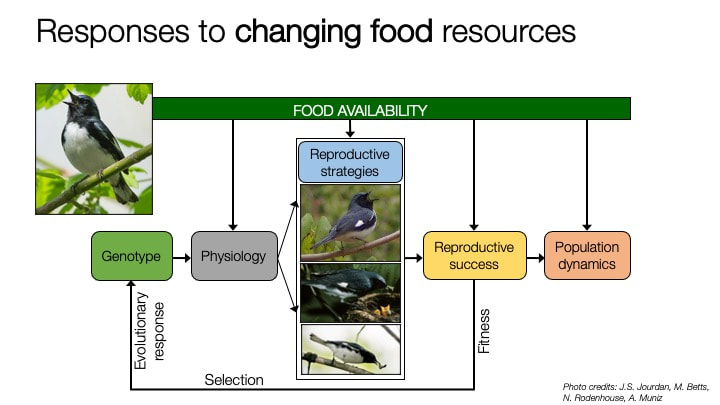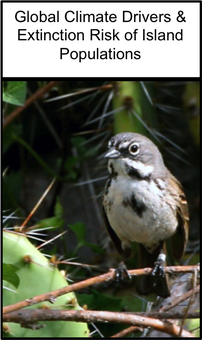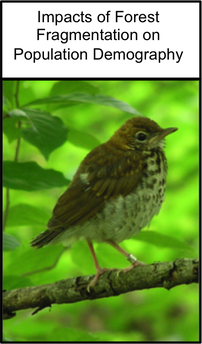Understanding how the environment shapes social behavior and behavioral responses to environmental change
My research focuses on how the environment shapes the evolution of complex social behavior, particularly reproductive strategies and cooperation in birds. I examine the role of social behavior in population and evolutionary dynamics involving sexual selection, population differentiation, and adaptation to environmental change.
I use a combination of field and lab methods including behavioral observations, endocrine and genomic approaches, and field experiments as part of long-term demographic studies. I link insights about the ecological context of social behavior with the underlying neuroendocrine and molecular mechanisms and individual variation in reproductive fitness within populations.
I use a combination of field and lab methods including behavioral observations, endocrine and genomic approaches, and field experiments as part of long-term demographic studies. I link insights about the ecological context of social behavior with the underlying neuroendocrine and molecular mechanisms and individual variation in reproductive fitness within populations.
geographic scope
ongoing research
Migratory Birds Responses to Changing Seasonality
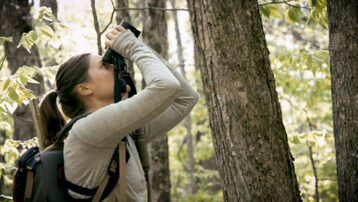
Click to watch The Resilient Forest by filmmaker Ben Silberfarb, accepted to the Wildlife Conservation Film Festival. This short film documentary explains the importance of Hubbard Brook’s long-term record and demonstrates how these data are put into action by local conservation groups that work with landowners to manage habitat for birds.
|
Our highly interdisciplinary team at the Cornell Lab of Ornithology, Smithsonian Migratory Bird Center, and external partner institutions study behavioral responses of migratory birds to climate change and the demographic effects of those responses. We link individual mechanisms, including behavior, physiology and genetic variation, to population dynamics. Our long-term population study of the black-throated blue warbler, Setophaga caerulescens, at the Hubbard Brook Experimental Forest is one of the longest and most comprehensive bird studies in the world.
We investigate the choices black-throated blue warblers make in response to climate change, which could directly impact their population dynamics.
Collaborators:
Michael Hallworth, Vermont Center for Ecostudies Richard Holmes, Dartmouth College Scott Sillett, Smithsonian Migratory Bird Center Michael Webster, Cornell Lab of Ornithology, Cornell University |
Conservation Genomics of Island Populations in the Caribbean
|
The geographic isolation of island populations can promote divergence by limiting the exchange of genetic and cultural information, such as learned vocalizations in songbirds. The behavioral mechanisms that lead to divergence and maintain barriers to gene flow is of particular importance in terrestrial species that have evolved migratory populations that come into contact with sedentary populations during their breeding cycle.
The grasshopper sparrow (Ammodramus savannarum) populations in the Caribbean Islands provide an excellent system for studying the role of learned song as a behavioral barrier to gene flow between migratory and sedentary populations. Four sedentary populations of grasshopper sparrow are found on different islands of the Caribbean and one endangered population exists in central Florida. The migratory subspecies that breeds throughout eastern North America spends the non-breeding season in the southern U.S. states and parts of the Caribbean. I am examining the hypothesis that sedentary populations will be both genetically and vocally more divergent on islands that do not come into contact with the migratory populations than on islands where gene flow between sedentary and migratory populations is possible. We investigate:
The presence of both migratory and sedentary phenotypes offers an ideal opportunity to examine which genes are involved in the expression of migratory behavior. Previous studies have identified candidate genes strongly associated with migratory bird activity. We are examining the generality of these findings. Collaborators:
Robert Fleischer, Smithsonian Center for Conservation Genomics Bernard Lohr, University of Maryland Baltimore |
Evolution of Complex Social Systems in Songbirds of the Old World Tropics
|
Cooperation between non-relatives is a long-standing puzzle in behavioral ecology. Most cooperative groups form when offspring delay dispersal and remain on their natal territory, resulting in groups composed of a breeding pair and non-breeding relatives that assist their parents in raising siblings. Recent work has revealed that social groups containing non-relatives are surprisingly common, but only a tiny fraction of group-living species has been studied. We explore how low genetic relatedness in social groups may select for different benefits of cooperation than in kin groups. We are exploring the diversity of cooperative social systems in group-living birds in the tropical montane forests of Malaysian Borneo – a region where few social systems have been characterized.
Collaborators:
Thomas Martin, University of Montana Robert Fleischer, Smithsonian Center for Conservation Genomics Juan Oteyza, University of Montana Julie Danner, Smithsonian Center for Conservation Genomics Madhvi Venkatramen, Smithsonian Center for Conservation Genomics Ellen Martinsen, Smithsonian Center for Conservation Genomics Andy Boyce, University of Montana Connor Armstad, University of Montana |
Mechanisms of Adaptive Responses to Environmental Change
|
An emerging question in behavioral ecology is whether and how behavioral plasticity will enable organisms to adjust to rapid environmental change. Behavioral plasticity is one potential mechanism that can buffer individuals within a population against environmental change and facilitate adaptive evolution. Such plasticity depends on both the sensitivity to environmental stimuli and the physiological mechanisms that animals use to regulate seasonal reproduction. A strong candidate proximate mechanism underlying adaptive behavioral plasticity is the neuroendocrine system. A critical gap in our knowledge, however, is how environmental stimuli are perceived and then translated by the neuroendocrine system to mediate the phenotypically plastic expression of reproductive behaviors. Understanding these links is especially timely given that rapid environmental change has exposed animals to modifications in habitat quality and environmental stimuli such as food availability. These changes in breeding condition can influence mating decisions and reproductive success.
Sensitivity of the neuroendocrine system to environmental stimuli, as well as plasticity and constraints in the signaling mechanism, will determine the extent to which animals will be able to respond. We explore the mechanisms underlying adaptive behavioral responses to determine the potential evolutionary constraints on these responses and whether adaptive plasticity in behavior is sufficient to compensate for rapid environmental change. We are examining mechanistic links between environmental stimuli (food), hormone responses, plasticity in reproductive behaviors, and fitness consequences in a migratory songbird, the black-throated blue warbler, Setophaga caerulescens, at the Hubbard Brook Experimental Forest in New Hampshire. Collaborators:
Scott Sillett, Smithsonian Migratory Bird Center Michael Webster, Cornell Lab of Ornithology, Cornell University |
PAST RESEARCH
Click each project to learn more about my previous scientific contributions.
©S.A. Kaiser 2012
